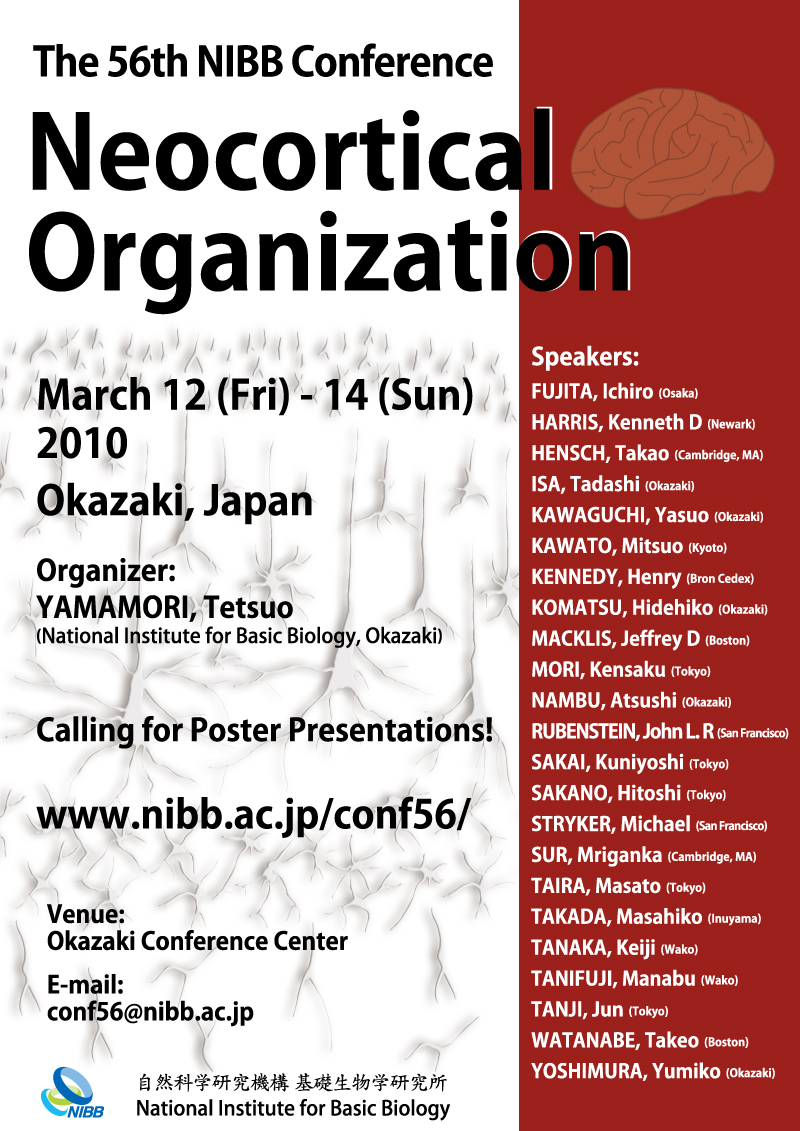
National Institute for Basic Biology




| Organizers | Tetsuo Yamamori (NIBB) |
|---|---|
| Venue | Okazaki Conference Center, Okazaki, Japan |
| Date | Mar. 12-14, 2010 |
| Link | Official Website (http://www.nibb.ac.jp/conf56/) |
| Poster |

|

The neocortex is a unique structure in mammals and thought to be the center that directs their perceptions and behaviors. As such it has been a main focus in neuroscience for over a hundred years. However, only recently have we been able to study the mechanisms for the formation and function of the neocortex at the molecular level. I therefore decided that it was a good time to organize a meeting in such a way that it could serve as a catalyst for interaction between the following two aspects of research on Neocortical Organization. One was as a venue for studies on the functional and genetic organization of the neocortex. The other was that it would also serve as an opportunity for interaction between leading Japanese and international researchers who are carrying out cutting-edge research in the field.
The symposium was organized into the following five sessions.
Session 1: Formation of Cortical Neural Specificity
Session 2: Functional Organization of Cortical Networks in the Visual and Auditory Systems
Session 3: Functional Organization of Cortical Networks in Primates and Humans
Session 4: Motion Control and the Anatomical and Physiological Basis
Session 5: Higher Cognition and Representation
The symposium was a success, and I would like to share the concluding remarks as presented by Prof. Michael Stryker (https://www.nibb.ac.jp/conf56/report.html) during the final session of the symposium. Here, I only cite his last two remarks.
“International meetings can be enormously useful, as well as pleasant. This meeting gives us much more than a similar investment of time spent reading one another’s papers. For one, we have the chance to ask and answer questions about points we may have misunderstood, or points for which we don’t find the published evidence convincing. The result of such discussions may be more experiments, a different analysis, or sometimes just a clarification. In addition, we get to hear and understand and discuss plans for future directions, which can improve all our future work. We also learn about new tools that our colleagues have created. Finally, the Poster Sessions in particular give us foreigners the opportunity to meet many brilliant and energetic young Japanese student scientists, and they to meet us, forming a basis for future scientific exchanges and postdoctoral fellowships.
Finally
Let us end with an expression of thanks to the National Institute of Basic Biology and to Professor Yamamori for this stimulus to progress in neuroscience, and for this celebration of Community between Japanese and Western science.
Arigato
Michael Stryker, Professor, UCSF”
(Tetsuo Yamamori)
| March 12 (Fri) at Okazaki Conference Center | |
| 09:00-09:10 | Opening Remarks Tetsuo Yamamori (NIBB, Japan) |
| Session 1 Formation of Cortical Neural Specificity | |
| 09:10-09:55 | “Activation and Inhibition of FGF-Signaling Mechanisms That Control Cortical Patterning” |
|
John L. R. Rubenstein (UCSF, USA)
|
|
| 09:55-10:40 | “Neural Map Formation in the Mouse Olfactory System” |
| Hitoshi Sakano (Univ. Tokyo, Japan) | |
| 10:40-10:55 |
Coffee Break
|
| 10:55-11:40 | “Parallel Mitral- and Tufted-Cell Streams in the Central Olfactory System” |
| Kensaku Mori (Univ. Tokyo, Japan) | |
| 11:40-12:25 | “Molecular Logic of Neocortical Projection Neuron Development and Repair” |
| Jeffrey D. Macklis (Harvard Univ., USA) | |
| 12:25-13:30 |
Lunch
|
| 13:30-13:45 | “Spatiotemporal Post-Transcriptional Regulation of Cyclin D2 mRNA Induces Asymmetrical Cell Fates in Neuroepithelial Cells and Self-Organization of Corticogenesis” |
| Noriko Osumi (Tohoku Univ., Japan) | |
| 13:45-14:30 | “Cortical Neuron Diversity and Local Connection Selectivity” |
| Yasuo Kawaguchi (NIPS, Japan) | |
| Session 2 Functional Organization of the Cortical Networks in the Visual and Auditory Systems | |
| 14:30-15:15 | “Critical Period Plasticity in the Visual and Auditory Systems” |
| Takao Hensch (Harvard Univ., USA) | |
| 15:15-15:30 |
Coffee Break
|
| 15:30-16:15 | “Cell-Specific Circuits and Plasticity in Visual Cortex” |
| Mriganka Sur (MIT, USA) | |
| 16:15-17:00 | “How Neural Activity and Molecular Cues Guide the Formation of Cortical Maps and Connections Between Brain Areas” |
| Michael P. Stryker (UCSF, USA) | |
| 17:00-17:20 | “Difference in Binocularity and Ocular Dominance Plasticity Between GABAergic and Excitatory Cortical Neurons, as Revealed by In Vivo Two-Photon Functional Ca2+ Imaging” |
| Tadaharu Tsumoto (RIKEN BSI, Japan) | |
| 17:20-17:35 |
Coffee Break
|
| 17:35-18:20 | “Activity Dependent Maturation of Functional Local Circuits” |
| Yumiko Yoshimura (NIPS, Japan) | |
| 18:20-19:05 | “Organization of Spiking Activity in Neuronal Populations of Auditory Cortex” |
| Kenneth D. Harris (Imperial College London, UK) | |
| March 13 (Sat) | |
| Session 3 Functional Organization of the Cortical Networks in Primates and Humans | |
| 09:00-09:45 | “Principles of Interareal Cortical Networks” |
| Henry Kennedy (Inserm U846, France) | |
| 09:45-10:30 | “Analysis of Cortical-Area Specific Gene Expressions in the Old World Monkey Reveals Large Domain Structures in the Primate Neocortex” |
| Tetsuo Yamamori (NIBB, Japan) | |
| 10:30-10:50 |
Coffee Break
|
| 10:50-11:35 | “Diversity of Pyramidal Neurons Across Neocortical Areas in the Primate: Biophysics, Morphology, and Postnatal Development” |
| Ichiro Fujita (Osaka Univ., Japan) | |
| 11:35-12:20 | “Hierarchically Organized ‘Functional Structures’ in Monkey Inferior Temporal Cortex” |
| Manabu Tanifuji (RIKEN BSI, Japan) | |
| 12:20-13:30 |
Lunch
|
| 13:30-14:15 | “Color Processing in Higher Cortical Areas of the Monkey” |
| Hidehiko Komatsu (NIPS, Japan) | |
| 14:15-15:00 | “Perceptual Learning as a Result of an Exposed Feature Being Internally Enhanced” |
| Takeo Watanabe (Boston Univ., USA) | |
| 15:00-15:20 |
Coffee Break
|
| Session 4 Motion Control and the Anatomical and Physiological Basis | |
| 15:20-16:05 | “Contrast in the Use of the Supplementary and Pre-Supplementary Motor Areas of Primates” |
| Jun Tanji (Tamagawa Univ., Japan) | |
| 16:10-18:10 | Poster Session List of Poster titles |
| 18:30-20:30 |
Social Meeting (Banquet)
|
| March 14 (Sun) | |
| 09:00-09:45 | “Cortico-Basal Ganglia Loop and Movement Disorders” |
| Atsushi Nambu (NIPS, Japan) | |
| 09:45-10:30 | “Cerebral Network for Behavioral Control: Parietal/Temporal-Prefrontal-Motor Links” |
| Masahiko Takada (Kyoto Univ., Japan) | |
| 10:30-10:50 |
Coffee Break
|
| 10:50-11:35 | “Cortical Compensatory Mechanism After Spinal-Cord Injury” |
| Tadashi Isa (NIPS, Japan) | |
| 11:35-12:20 | “Neural Mechanisms for Navigation” |
| Masato Taira (Nihon Univ., Japan) | |
| 12:20-13:30 |
Lunch
|
| Session 5 Higher Cognition and the Representation | |
| 13:30-14:15 | “Functional Differentiation among Primate Prefrontal Areas in Goal-Directed Behavior” |
| Keiji Tanaka (RIKEN BSI, Japan) | |
| 14:15-15:00 | “Finding Common and Concise Representation for Brain, Body and Environment” |
| Mitsuo Kawato (ATR, Japan) | |
| 15:00-15:45 | “The Foundation of Human Language” |
| Kuniyoshi L. Sakai (Univ. Tokyo, Japan) | |
| 15:45-16:00 | Concluding Remarks |
| Michael P. Stryker (UCSF, USA) | |